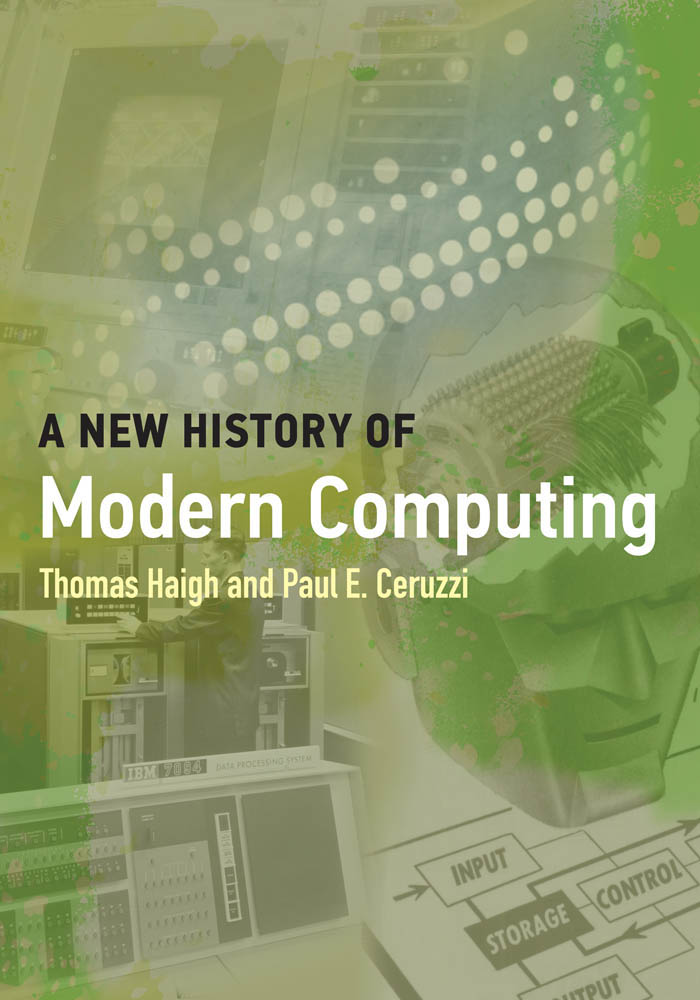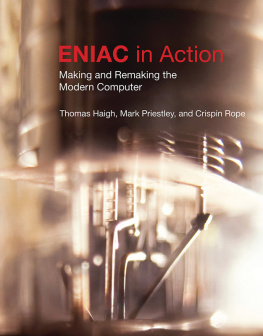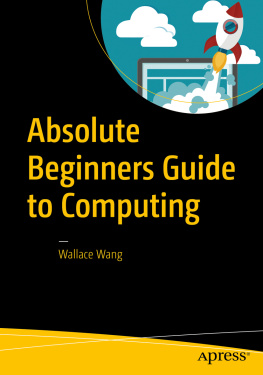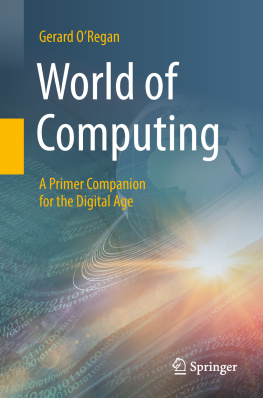Contents
Guide
Pagebreaks of the print version

HISTORY OF COMPUTING
William Aspray and Thomas J. Misa, editors
A complete list of the titles in this series appears in the .
A NEW HISTORYOF MODERNCOMPUTING
THOMAS HAIGH AND PAUL E. CERUZZI
The MIT Press
Cambridge, Massachusetts
London, England
2021 Smithsonian Institution
All rights reserved. No part of this book may be reproduced in any form by any electronic or mechanical means (including photocopying, recording, or information storage and retrieval) without permission in writing from the publisher.
The MIT Press would like to thank the anonymous peer reviewers who provided comments on drafts of this book. The generous work of academic experts is essential for establishing the authority and quality of our publications. We acknowledge with gratitude the contributions of these otherwise uncredited readers.
Library of Congress Cataloging-in-Publication Data
Names: Haigh, Thomas, 1972 author. | Ceruzzi, Paul E., author.
Title: A new history of modern computing / Thomas Haigh and Paul E. Ceruzzi.
Description: Cambridge, Massachusetts : The MIT Press, [2021] | Series: History of computing | Includes bibliographical references and index.
Identifiers: LCCN 2020048457 | ISBN 9780262542906 (paperback)
Subjects: LCSH: Computer scienceHistory. | Electronic digital computersHistory.
Classification: LCC QA76.17 .H34 2021 | DDC 004.09dc23
LC record available at https://lccn.loc.gov/2020048457
d_r0
To Prof. Dr. Erhard Schttpelz and to the SIGCIS community, both vital sources of support for our work
CONTENTS
List of Figures
ENIAC as installed at the University of Pennsylvania, in a US Army photograph used by theNew York Timesin its 1946 report. This image defined public ideas of what an electronic computer looked like. The machine was configured by setting switches and wiring connections between its many panels, which collectively established a room within a room in which its operators and associated punched card machinery worked. Corporal Irwin Goldstein, an Army maintenance technician, is in the foreground setting data on a portable function table later used to hold encoded program instructions. Technician Homer Spence and two operators, Frances Bilas and Betty Jean Jennings (later Jean Bartik), work in the background.
The logical architecture of EDVAC as described in theFirst Draft. Reproduced from Thomas Haigh, Mark Priestley, and Crispin Rope,ENIAC in Action(Cambridge, MA: MIT Press, 2016, p. 145).
The staff of the Eckert-Mauchly Computer Company gather in 1948 at their Philadelphia factory, in front of their first computer, the custom BINAC created for military aircraft developer Northrop. Front row (left to right): J. Presper Eckert (cofounder and ENIAC chief engineer), Frazier Welsh, James Wiener, Bradford Sheppard, and John Mauchly (cofounder and ENIAC project initiator). Back row: Albert Auerbach, Jean Bartik (former ENIAC operator and programming manager), Marvin Jacoby, John Sims, Louis Wilson, Robert Shaw (former ENIAC engineer), and Gerald Smoliar. Courtesy Unisys Corp.
Magnetic core memory. 1953 IEEE. Reprinted, with permission, from Jan A. Rajchman, A Myriabit Magnetic-Core Matrix Memory,IRE Proceedings(October 1953): 1408.
Advertisement for ERA Drum memory, 1953. Small electronics firms used ERA drums to enter the computer business. Note the simplified diagram of a von Neumann architecture, which was novel at the time.
SourceElectronicsmagazine, April 1953, p. 397. Courtesy Unisys.
Grace Hopper, with students Donald Cropper, K. C. Krishnan, and Norman Rothberg, at a Univac I console, c. 1960. Photo courtesy Division of Medicine and Science, National Museum of American History, Smithsonian Institution.
The transistorized IBM 7094 was the most versatile of IBMs early mainframes. Note the four additional index register readouts, mounted on top of the standard IBM 7090 console.
Source: IBM.
An IBM 7090 Direct Couple System in use at North American Aviation, c. 1962. Note the rows of tape drivestwenty-one visible in this photo. Magnetic tape was the primary mass storage medium for second-generation mainframe computers. Photo by Robert W. Kelley/The LIFE Picture Collection via Getty Images.
The Cray 1s cooling units, several of which are exposed here, were usually covered with upholstery so that the supercomputer, which was for six years the worlds fastest also offered a comfortable place to sit. Photo by Eric Long, National Air and Space Museum, Smithsonian Institution (NASM 2006937).
Computer installations on college campuses often created images composed of text characters to show off the capabilities of the IBM Chain Printer. Such pictures were later shared online. This widely shared example of what was later called ASCII art was reportedly created by David Wright in 1978.16
An IBM RAMAC disk unit is loaded onto a Pan American Airways aircraft, for its installation at the Brussels Worlds Fair, 1957. The drive had a capacity of five million characters and required two additional cabinets holding power supplies and controller electronics to function. Courtesy of International Business Machines Corporation, International Business Machines Corporation.
An IBM System 360 installation, c. 1965. Well into the third generation, mainframe computers still relied heavily on magnetic tape for mass storage. Note the raised floor, punched card reader, the typewriter-like console printer, and next to it, an IBM 3270 video terminal and the distinctive slope of the main console. At the lower left is a suite of fixed disk drives; at the lower right, a set of chain printers housed in soundproofed cabinets. Courtesy of International Business Machines Corporation, International Business Machines Corporation.
System/360 was designed for technical computing as well as business data processing. In both markets, IBMs fast and rugged chain printers were a crucial selling point. This page, simulating a lunar trajectory, was printed at the MIT lab responsible for the Apollo guidance computer on October 23, 1968, a few months prior to the Apollo 8 mission. Smithsonian National Air and Space Museum (NASM 9A1259345506-A).
Consultant W. Robert Widener promoted the concept of management decision rooms based around computerized screens with armrest controls in his 1968 article New Management Concepts.
By the mid-1960s, Univac promoted its computers as total management information systems with almost magical powers to centralize and simplify the control of large diversified corporations.Fortune, October 1965, pages 3233. Courtesy Unisys.
This M9 gun was controlled by a director built at Bell Labs: an analog electronic computer.
Source: Bell Labs, AT&T. Alcatel-Lucent
A SAGE console and part of the processor. Note the light gun in the protective box next to the display scope. Courtesy of the Computer History Museum.













